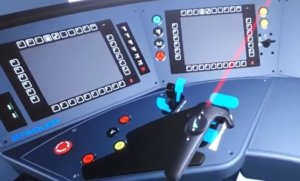Welcome to our recurring post, Rail Tech Talk, highlighting how technology is helping the Rail Industry charge forward.
Train Station Workers Learn Ropes with Virtual Simulations
 Using Virtual Reality, MTR Crossrail in London has developed a platform that “allows trainee staff to walk around and interact with objects using movements and arm gestures. Training is staged across a number of scenarios, from reporting faults on critical station equipment, to dealing with safety hazards that would be too dangerous to replicate in real life.”
Using Virtual Reality, MTR Crossrail in London has developed a platform that “allows trainee staff to walk around and interact with objects using movements and arm gestures. Training is staged across a number of scenarios, from reporting faults on critical station equipment, to dealing with safety hazards that would be too dangerous to replicate in real life.”
It isn’t designed to replace current training, but rather to enhance it. Citing studies that speak to VR training leading to superior learner retention, this simulated station is meant to act as a proof of concept training – one that they hope will expand out to other immersive and interactive training opportunities.
Another benefit is the ability to “have two people in the same environment at the same time.” They can interact, as they would in their real-life roles, and can take on different roles to have a better holistic view of the operation. It’s cross-training of the future!
And then the portability of the training is major plus to them. “The VR kits you see in demos can probably be put it in a holdall with a powerful laptop. Instead of having everyone come to a training centre, it’s transferrable. . . .and [you’re no longer] geographically constrained from a training centre, where everyone’s got to come to you.” The ROI there will be incredible.
Designing & Testing Trains with VR
Swiss train builder, Stadler, now offers VR headsets so drivers can have an immersive experience where they see inside train cabs before they’ve been built. This allows them to “offer essential feedback on the controls, layout, and instrument displays.”
“Computer-generated images allow drivers to offer feedback on the controls, layout and instrument displays”
 Not only does this help with design, but it also helps drivers better prepare for changes, as they can “get a feel for the new trains from the very early stages of the project and . . . this ultimately saves time and resources.” It also help railways better prepare for training, by “helping facilitators understand and address roadblocks in the learning process and create tailored training experiences.”
Not only does this help with design, but it also helps drivers better prepare for changes, as they can “get a feel for the new trains from the very early stages of the project and . . . this ultimately saves time and resources.” It also help railways better prepare for training, by “helping facilitators understand and address roadblocks in the learning process and create tailored training experiences.”
And this simulation training is also COVID-friendly, which is an unexpected benefit during these challenging pandemic-affected times.
Be sure to check out our Rail Virtual Training Solutions to see why BNSF, CSX, Amtrak, NS, UP, CN & KCS partner with Heartwood to deploy a variety of railroad training simulations and guides. And if you have any questions about these technologies, please reach out!


